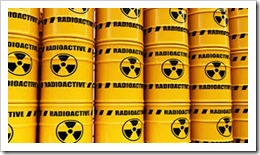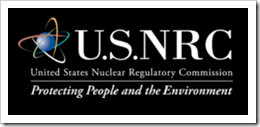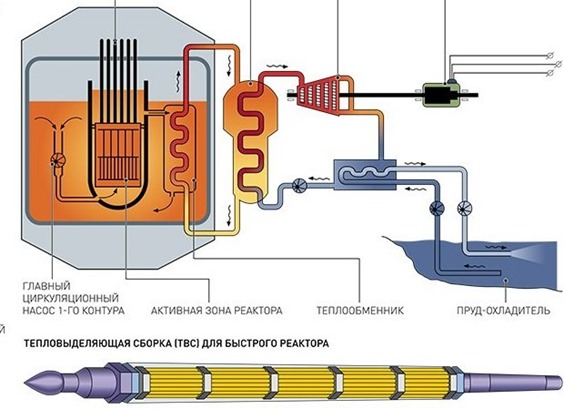- DOE to Issue RFP for $2.7 Billion for Domestic Uranium Supply
- Nuclear Startup Atomic Canyon Partners with ORNL on AI Models
- NRC Working on AI but Use Cases Need Definition
- Oklo Signs MOU with Atomic Alchemy to Collaborate on Isotope Production
- BN-1200 Plans Clear Environmental Hurdle
- First Terrapower Advanced Reactor On Schedule But Fuel is a Concern
DOE to Issue RFP for $2.7 Billion for Domestic Uranium Supply
- Agency will open bidding for supply of domestically produced low-enriched uranium.
- Action follows signing by president Biden of law banning imports from Russia
(NucNet) The US will open bidding next month for contracts worth as much as $3.4 billion for the supply of domestically produced low-enriched uranium for nuclear reactor fuel.
Of that amount, $2.7 billion of the funding comes from a broader plan to stop using nuclear fuel imported from Russia. It will help restart domestic nuclear fuel production by making direct purchases of the low-enriched uranium used in reactors.
The $2.7 billion was authorized after president Joe Biden signed a ban on on 05/13/24 on imports of enriched uranium from Russia. About a quarter of the reactor fuel in the US comes from Russia making it the country’s top supplier. In the middle of the Ukraine war, the ban is intended to stop using US payments for Russian uranium to prop up that nation’s economy.
The ban goes into effect 90 days after it was signed into law and prohibits any imported unirradiated low-enriched uranium (LEU) produced in the Russian Federation or by a Russian entity. Russia has roughly 44% of the world’s uranium enrichment capacity and supplies approximately 35% of US imports for nuclear fuel. The ban will remain in effect until 2040.
DOE estimates that US utilities have roughly three years of LEU available through existing inventory or pre-existing contracts. To ensure US nuclear plants do not experience any disruptions, the legislation created a waiver process to allow some imports of LEU from Russia to continue for for the next five years.
Wyoming Republican John Barrasso, one of the sponsors of the legislation signed by Biden, said he had fought for years to end America’s reliance on Russian nuclear fuel. In a press statement, the senator said;
“Today, we officially ended Russia’s chokehold on America’s uranium supply. Banning imports of Russian uranium will jumpstart America’s nuclear fuel industry, further defund Russia’s war machine, and help revive American uranium production for decades to come.”
Wyoming has the largest known uranium ore reserves of any state in the US followed by New Mexico, Colorado, and Texas. Uranium mining in the US consists of both hard rock operations and in situ recovery.
Separately, Centrus Energy recently delivered a first batch of HALEU fuel to DOE in the first phase of a domestic manufacturing demonstration process.
On an international basis, the US is collaborating in a strategic partnership between the United States, United Kingdom, Canada, France, and Japan to support the stable supply of fuels for existing, operating reactors and to enable the development and deployment of fuels for future advanced reactors.
To date, the partnership has mobilized more than $4.2 billion in government-led investments to support the development of a secure, reliable global nuclear energy supply chain.
& & &
Nuclear Startup Atomic Canyon Partners with ORNL on AI Models
Atomic Canyon, a nuclear startup based in San Obispo, CA, announced a new project with the Department of Energy’s Oak Ridge National Laboratory (ORNL), home of the Frontier supercomputer, to build an open-source AI model for the nuclear sector.
Atomic Canyon will use Frontier, the world’s fastest supercomputer, to train the company’s AI model to understand complex nuclear terminology.
The Oak Ridge Leadership Computing Facility, home to the Frontier supercomputer, is a US Department of Energy User Facility funded by DOE’s Office of Science. The project is funded by the Oak Ridge Leadership Computing Director’s Discretion at no cost to Atomic Canyon.
Atomic Canyon said the purpose of the project is to develop open-source nuclear sector terminologies, develop a nuclear AI infrastructure to build upon, and to provide a powerful tool for efficient data navigation, document indexing, performance improvement and cost savings.
This advanced technology, developed by Atomic Canyon and trained on millions of publicly available documents from the. Nuclear Regulatory Commission’s Agency-wide Documents Access and Management System (ADAMS), will utilize sentence-embedding models. These algorithms convert written sentences into numerical representations to allow AI to grasp nuclear terminology and accurately discern information.
The company said in its press statement, “This deeper understanding makes the AI more effective and helps prevent AI ‘hallucinations’ and biases during search and data analysis. Atomic Canyon’s technology will provide innovators with trusted, accurate assistance in understanding the broad spectrum of nuclear safety and security requirements.”
A caveat for the project is that the model will not be trained on sensitive information on the design or operation of nuclear technologies. The firm said the AI application will be able to assist with analyzing a vast array of public regulatory guides, inspection reports, and other documents, “with the goal of increasing safety and public accountability.”
Frontier, the world’s fastest and the first to achieve “exascale” computing performance (a quintillion calculations per second), will play a pivotal role in the collaboration between Atomic Canyon and ORNL. This project promises significant benefits for nuclear researchers, scientists, engineers, and stakeholders. As an open source project, the results will be available on the Internet to a global user community.
“Our leading-edge technology is tailored to the nuclear sector,” says Trey Lauderdale, CEO and founder of Atomic Canyon.
“Collaborating with ORNL’s premier supercomputing facilities such as Frontier will help our platform understand complex nuclear concepts, removing a major barrier to AI implementation in the nuclear sector. Moreover, our open-source approach will encourage transparency and collaboration among nuclear stakeholders and innovators focused on safety and security. Our goal is to help the world’s best and brightest have the information and technology they need to help navigate the climate and energy crisis.”
“Open-source AI search, trained using the lab’s Frontier supercomputer, will play an essential role in the research, engineering, and development of nuclear energy and the nuclear sector, now and into the future,” says ORNL’s Thomas M. Evans, Group Lead and Distinguished R&D Staff, HPC Methods for Nuclear Applications. “This is crucial to advance nuclear innovation and move toward a future powered by sustainable energy.”
Prior coverage on this blog; Startup Offers AI Tool to Access NRC’s ADAMS Library
NRC Working on AI but Use Cases Need Definition
The NRC’s fiscal year 2025 budget includes a $4.43 million request for AI regulatory framework for the nuclear industry. Dave McIntyre, an NRC public affairs officer, shared in an email with FedScoop that agency staffers are “preparing a status update to send the Commission this spring outlining next steps to integrate AI across the agency, invest in the necessary IT infrastructure and recruit and train staff in AI skills.”
According to the agency’s public affairs office, the NRC has conducted “some limited risk assessments” of generative AI tools that are publicly available to “help us develop our policy statement.”
As a regulatory agency, the NRC is exercising considerable caution in ramping up AI capabilities. The spokesperson told Fedscoop that the agency plans to continue working with the Cybersecurity and Infrastructure Security Agency and others on risk management, in addition to working on security controls and risk mitigation as NRC implements internal AI tools.
Policy for Use Cases
The agency has an internal initiative underway to develop AI use cases but has embargoed public access to detailed information about them. The agency said it is too early for the agency to say which use cases will be applied to future regulatory processes.
However, last month a publicly accessible document from ADAMS [SECY-24-0035] [ML24086A002] laid out the policy approach being taken by the agency. It described 61 AI use cases in general detail and laid out the strategies for using them.
(1) Develop an enterprise-wide AI strategy to advance the use of AI within the agency.
- Prepare AI governance to ensure responsible and trustworthy AI implementation.
- Mature the agency Data Management Program.
- Strengthen AI talent by strategically hiring and upskilling the existing workforce.
- Allocate resources to support the integration of AI tools as part of the IT infrastructure.
(2) Invest in foundational tools to advance the use of AI by (1) acquiring generative AI5 services that integrate with current applications, and (2) integrating the use of AI with the Agencywide Documents Access and Management System (ADAMS) cognitive search technology.
& & &
Oklo Signs MOU with Atomic Alchemy to Collaborate on Isotope Production
Oklo Inc. (NYSE:OKLO) Oklo, a fast fission clean power technology and nuclear fuel recycling company, is forming a strategic partnership with Atomic Alchemy Inc., based in Idaho Falls, ID,. to produce nuclear isotopes.
This partnership will aim to combine Oklo’s work to build and operate fast reactors and fuel recycling expertise with Atomic Alchemy’s expertise in isotope production to meet increasing demands for isotopes. Isotopes are vital for many promising medical, energy, industry, and science applications.
The strategic partnership between Oklo and Atomic Alchemy can help address the gaps in our domestic supplies of isotopes and tritium, helping reduce dependence on foreign suppliers. The scope of actions includes;
- Oklo and Atomic Alchemy are forming a strategic partnership to produce radioisotopes from Oklo’s recycling process and through fast reactor production of isotopes.
- The partnership will aim to increase the production of industrial and medical isotopes vital for cancer treatment, diagnostic imaging, and clean energy technologies.
- This U.S.-based partnership would help establish a reliable domestic supply, help meet the current and anticipated demand for isotopes, and aim to address gaps in the supply chains.
Jacob DeWitte, co-founder and CEO of Oklo, said, “Our partnership with Atomic Alchemy will enable us to diversify our product offerings with radioisotopes produced from our fuel recycling process.
Sam Altman, Chairman of Oklo, added, “This partnership is an example of some of the promising aspects of Oklo’s recycling plans, with large potential benefits to a number of industries.”
“The world is facing a shortage of vital isotopes. We are witnessing many promising cancer therapies stuck in clinical trials, unable to secure sufficient quantities of isotopes in a timely manner. I’m proud to be partnering with Oklo to help expand our domestic supplies of isotopes and tritium.”
Thomas Eiden, Founder and CEO of Atomic Alchemy, said, “Atomic Alchemy is advancing its mission through the construction of a scalable, fully vertically integrated radioisotope production facility.”
In its press statement, Oklo said the company is working on including complementary applications like radioisotopes, given its strong balance sheet with over $300 million of cash on hand following its recently completed business combination with AltC Acquisition Corp.
Oklo added it will utilize its funding position to execute on the customer interest in its Aurora powerhouse offering to meet the rapidly expanding electric power needs of the artificial intelligence, data center, energy, defense, and industrial markets, among others.
& & &
BN-1200 Plans Clear Environmental Hurdle
(WNN) The Russian environmental regulator Rosprirodnadzor has approved the plans for a BN-1200M fast sodium reactor at the Beloyarsk nuclear power plant.
BN-1200 Conceptual Diagram. Image: Rosatom
According to Rosatom, Rosprirodnadzor said that its investigations showed that “there is no significant impact on the environment” and the project meets the requirements of environmental legislation. The response will be included in documents submitted to Russia’s nuclear regulator Rostechnadzor, who will decide on issuing a licence for the proposed new nuclear power unit.
Ivan Sidorov, director of the Beloyarsk nuclear power plant, said that as part of the development of next generation – Generation IV – reactors, Rosatom “is creating a new technological platform for the deployment of nuclear energy of the future, based on fast reactors operating in a closed nuclear fuel cycle.”
Significantly, he said it will be the prototype of a serial power unit as they seek to move from “single unique projects, such as BN-600 and BN-800,” to serial production of the BN-1200.” In other words, after more than a decade of design work, Rosatom is now planning to build a fleet of advanced reactors.
The sodium-cooled BN-series fast reactor plans are part of Rosatom’s project to develop fast reactors with a closed fuel cycle running on mixed-oxide (MOX) fuel.
In addition to the BN-600 reactor, which began operation in 1980, the 789 MWe BN-800 fast neutron reactor – constructed as Beloyarsk unit 4 – entered commercial operation in October 2016. This is essentially a demonstration unit for fuel and design features for the larger BN-1200, which will be unit 5 at Beloyarsk.
Rosatom says the projects at Beloyarsk nuclear power plant, in the Sverdlovsk region, are aimed at “solving the strategic task of the nuclear industry to develop a closed nuclear fuel cycle, which will provide fuel for the nuclear power industry for hundreds of years, allow for the reuse of used nuclear fuel and minimize radioactive waste.”
& & &
First Terrapower Advanced Reactor On Schedule But Fuel is a Concern
The Reuters wire service reported 05/09/23 that

TerraPower is confident its first Natrium advanced nuclear reactor will be built by 2030 with construction plans and licensing running smoothly, but fuel supply remains a concern, the company said.
TerraPower noted that it submitted the construction permit application for its Natrium advanced reactor to the Nuclear Regulatory Commission in March adding that it sees itself as being well on its way to deploy the first-of-a-kind reactor by 2030.
Natrium is a 345 MWe sodium-cooled fast reactor with molten salt-based energy storage system and was originally projected to begin generating power in 2028. However, after Russia invaded Ukraine in 2022, that action cut off supplies of HALEU fuel as Russia was the only source of it.
TerraPower told Reuters that fuel supply remains TerraPower’s main concern for the first plant, on which the company expects to begin non-nuclear-related construction in June,
Director of External Affairs at TerraPower Jeff Navin, told the wire service the supply of HALEU was considered the greatest uncertainty when planning for deployment.
“We still think 2030 is our best bet as to when we can get things completed, but I can’t tell you today that I can account for every kilogram of HALEU that we will need, where it will come from, and when we’ll have it, so that that is certainly something that still keeps us up at night.”
The Natrium, like almost all advanced nuclear reactor designs in the US, requires HALEU fuel to operate.
In 2023, TerraPower signed an agreement to cooperate with US-based enrichment services company Centrus Energy to establish commercial-scale, domestic production capabilities for Haleu for the Natrium plant.
TerraPower has also signed a memorandum of understanding with Texas-based uranium production and exploration company Uranium Energy Corp with the aim of reestablishing domestic supply chains of uranium fuel.
# # #
- SEO Powered Content & PR Distribution. Get Amplified Today.
- PlatoData.Network Vertical Generative Ai. Empower Yourself. Access Here.
- PlatoAiStream. Web3 Intelligence. Knowledge Amplified. Access Here.
- PlatoESG. Carbon, CleanTech, Energy, Environment, Solar, Waste Management. Access Here.
- PlatoHealth. Biotech and Clinical Trials Intelligence. Access Here.
- Source: https://energycentral.com/c/ec/doe-issue-rfp-27-billion-domestic-uranium-supply





